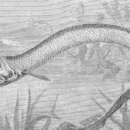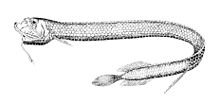en
names in breadcrumbs


Stomias boa is a common predator of meso- and bathypelagic oceanic waters. Two subpecies are recongnized: S. boa boa, known from the western Mediterranean, off West Africa and in the Southern Ocean, and S. boa ferox, known throughout much of the subtropical, tropical, and temperate Atlantic.. These taxa are distinguished by the number of photophores in the ventral row (see "Diagnostic Description").
View data on Catalog of Fishes here.
Barbel usually about as long as head, with 3 short filaments arising from end of distal bulb; upper jaw with a small anterior tooth, a large fang and 3 to 5 smaller teeth; lower jaw with 2 small anterior teeth, 2 large teeth and 3 to 7 smaller teeth. Six rows of hexagonal areas above lateral series of large photophores; 82–91 photophores in ventral series (IC, from anterior end of isthmus to fleshy part of tail). Color iridescent silver.
Temperate, subtropical, and tropical oceanic waters of the Atlantic; also in the Southerd Ocean and temperate latitudes of the Indian Ocean.
Deep oceanic waters to more than 1,000 m depth; may migrate to near-surface waters at night
Gibbs RH, Jr. 1984. Stomiidae. In: Whitehead PJP, Bauchot M-L, Hureau J-C, Nielsen J, Tortonese E, editors. Fishes of the North-eastern Atlantic and the Mediterranean. Paris: UNESCO. p 338–340.
Species of the genus Stomias are very elong and slender, with large jaws bearing fang-like teeth and a moderately long and posteriorly place dosrsal fin. Species of the genus are distinguished from other genera in the family Stomiidae by the following characters. Upper jaw extending to near anterior margin of preoperculum; premaxilla proctractile. Hyoid barbel long and slender, terminal bulb and filaments at tip. Maxilla with numerous small teeth on posterior half of ventral margin. Vomer with pair of teeth; palatine bearing one to three teeth. Gill arches bearing tack-like teeth rather than rakers. Floor of mouth present, membrane connecting halves of lower jaw to isthmus. Pectoral fin placed low on body; pelvic fin indserted nearer to caudal-fin base than to snout. Anal and dorsal fins opposite and placed far posteriorly on body. Dorsal adipose fin absent
Photophores present below eye, on brahciostegal membrane, in ventral row from isthmus to caudal-fin base and in lateral row from posterior margin of opercle to anal-fin origin; small luminescent organs scattered over head and body. Body covered with five or six rows of hexagonal scale pockets, and, when undamaged, covered with gelationous coat.
To more than 30 cm.
Midwater fishes and crustaceans.
Nice, Département des Alpes-Maritimes, France, northwestern Mediterranean Sea.
Holotype: MNHN A-2519. Possible syntype: SMF 753.

Stomias boa, also known as the boa dragonfish, scaly dragonfish, dragon-boa or boa scaly dragonfish, is a species of deep-sea fish in the family Stomiidae.[4][5][6][3][7]
Three subspecies are recognised:
Stomias boa has an elongated body and small head;[8] it is up to 32.2 cm (1.06 ft) in length, black underneath and iridescent silver on its flanks, with a barbel that has a pale stem, dark spot at base of bulb and three blackish filaments.[9][10] It has six rows of hexagonal areas above a lateral series of large photophores.[11] The dorsal and anal fins are opposite each other, just anterior to the caudal fin.[12]
Stomias boa is mesopelagic and bathypelagic, living at depths of 200–2,173 m (656–7,129 ft) in seas worldwide, particularly off the Atlantic coast of North America, in the Mediterranean and in a band 20°–45° S.[13][14][15] S. boa ferox is concentrated in the North Atlantic.[16] S. boa colubrinus is most common off the Congo coast and the northwest coast of South America.[17][18]
Stomias boa eats midwater fishes and crustaceans; it rises to near the surface to feed at night.[10]
Stomias boa is oviparous; its larvae are 9–44 mm (0.35–1.73 in) in length.[19]
 S. boa ferox
S. boa ferox  S. boa boa
S. boa boa  S. boa boa: the hexagonal areas above the photophores are visible.
S. boa boa: the hexagonal areas above the photophores are visible. Stomias boa, also known as the boa dragonfish, scaly dragonfish, dragon-boa or boa scaly dragonfish, is a species of deep-sea fish in the family Stomiidae.
Three subspecies are recognised:
Stomias boa boa (A. Risso, 1810) Stomias boa colubrinus (Garman, 1899) Stomias boa ferox (J. C. H. Reinhardt, 1842)